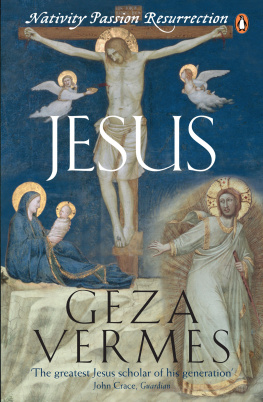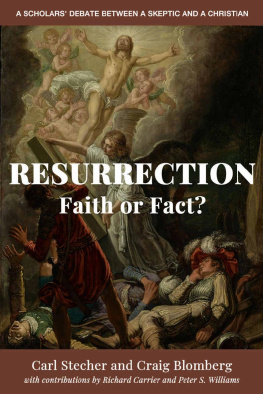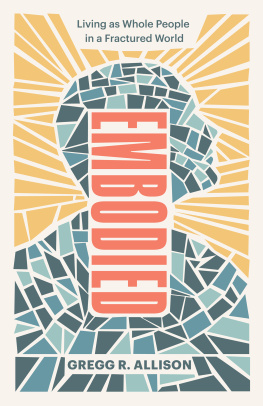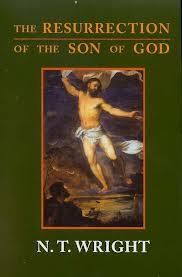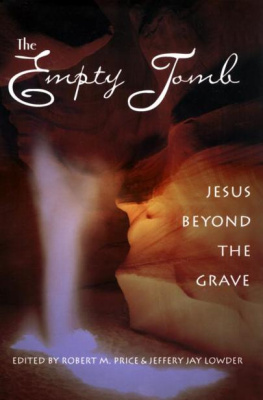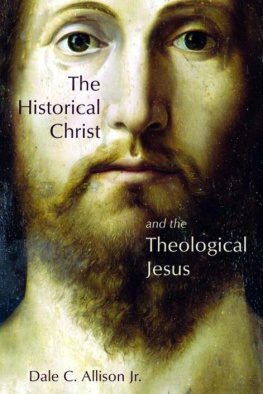Contents
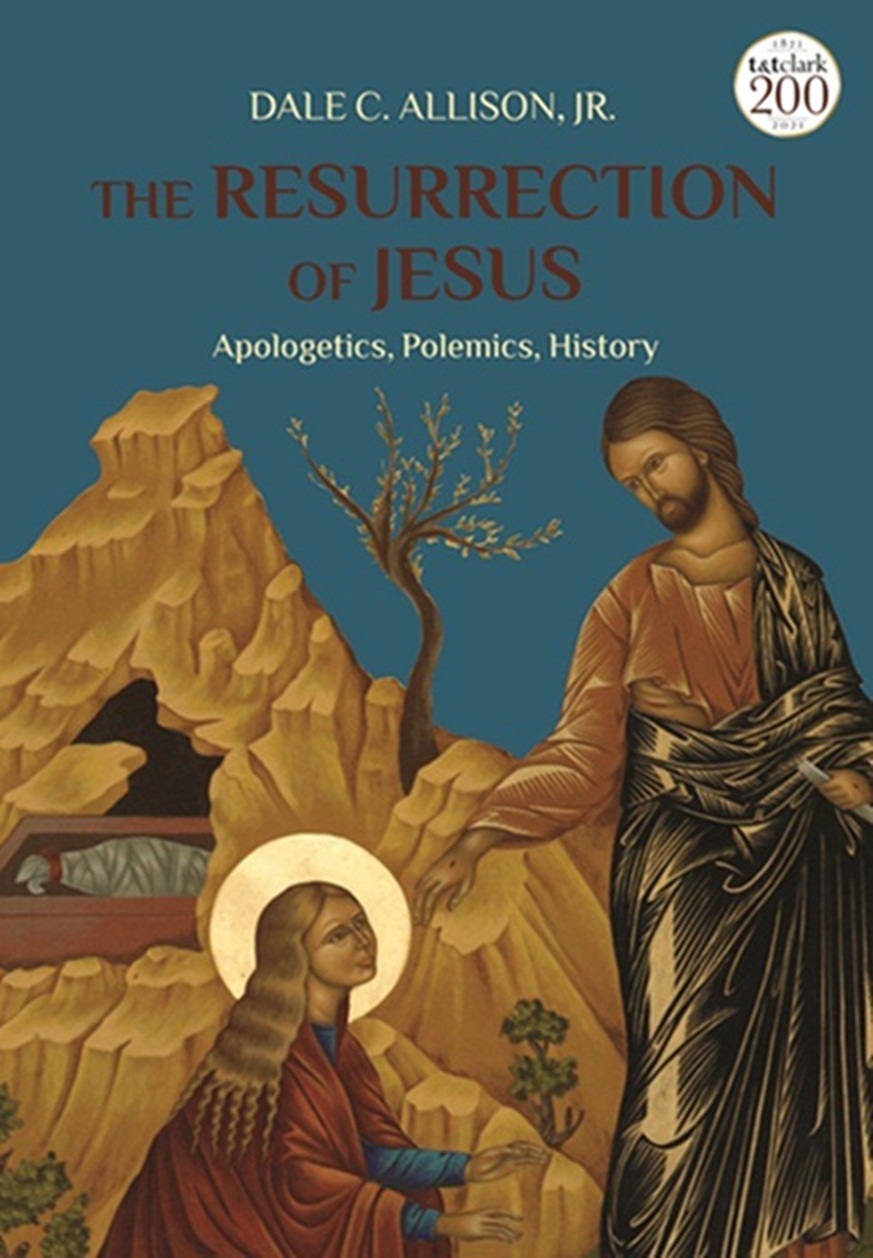
THE RESURRECTION OF JESUS

For Warren Farha,
who carries many of my most cherished memories.
CONTENTS
My first book, a revision of my doctoral dissertation, contained an excursus on the resurrection of Jesus. The present treatment is, as a result, more than three times the length of its predecessor.
I heartily thank those who have read and commented on portions of this manuscript, conversed with me about its topics, or otherwise helped me to bring it to completion: Kristine Allison, John Allison, Kathy Anderson, Clifton Black, Duncan Burns, Donagh Coleman, Tucker Ferda, Chuck Hughes, Ed Kelly, Chris Kettler, Mike Licona, Joel Marcus, Yee Jee Park, George Parsenios, Jeremiah Ravindranath, Heiner Schwenke, Michael Thate, and Stephen Wykstra (who saved me from one especially egregious gaffe). I am further grateful to reviewers of and commentators on my earlier work, above all to William Lane Craig, Stephen Davis, and Gary Habermas, who produced thoughtful responses for a meeting of the Evangelical Philosophical Society.
I am delighted to dedicate this book to Warren Farha, whom I have known now for forty-five years. We have shared the best of times and the worst of times. Even though he will judge that I have, in this book, gone astray on multiple critical issues, it should matter little. He will, like Jesus, freely forgive me for whatever mistakes he deems me to have made and for whatever heresies he thinks I have promulgated. Friendship covers a multitude of sins. Warren long ago counselled me, when I was fretting over the theological consequences of my earliest work, that I should follow the evidence wherever it leads and whatever the fallout. I have often recalled that sagacious counsel, not least of all in writing this book.
Dale C. Allison, Jr., The End of the Ages has Come: An Early Interpretation of the Passion and Resurrection of Jesus (Philadelphia: Fortress, 1985), 1638.
Dale C. Allison, Jr., Resurrecting Jesus, in Resurrecting Jesus: The Earliest Christian Tradition and Its Inte r preters (New York/London: T. & T. Clark, 2005), 198375. These pages grew out of the Zarley Lectures, which I delivered in November 2003 at North Park University in Chicago. Even now I warmly remember the occasion and the hospitality of Scot McKnight and Kermit Zarley.
Most significantly, I have excised pp. 21319 (Confession) and 21928 (Doubts). Those pages, which offer personal theological reflections, no longer accurately reflect what I think, and they are largely redundant in view of the fuller analysis of resurrection in my book, Night Comes: Death, Imagination, and the Last Things (Grand Rapids: Eerdmans, 2016), 1943.
are wholly new.
are, for example, more than twice the length of their forerunners.
The reporting often extends into long footnotes. The reason is that I wish at times to report, however imperfectly, on the history of various debates. As we move forward, we need to know where we have been. No less importantly, we need to exorcize the naive conceit, begotten by our technological ideology, where new is always best, that books and articles written of late deserve all our attention. I have, when working on this volume, consistently learned as much from the dead as from the living. I concede, however, that the relevant literature has become as the sands of the sea, so that no one can any longer gain a decent familiarity with it, a fact that should humble us all. I add that I have made only occasional forays into the impassioned, unedited, wild country of the internet, with its countless, often vitriolic debates about Jesus' resurrection. Seriously exploring that world would have required exiting the rest of life.
These, along with my response, were printed in Philosophia Christi 10/2 (2008): 285335.
Setting the Stage
Overture
When the mind is satisfied, that is a sign of diminished faculties or weariness. No powerful mind stops within itself: it is always stretching out and exceeding its capacities. It makes sorties which go beyond what it can achieve: it is only half-alive if it is not advancing, pressing forward, getting driven into a corner and coming to blows; its inquiries are shapeless and without limits; its nourishment consists in amazement, the hunt and uncertainty, as Apollo made clear enough to us by his speaking (as always) ambiguously, obscurely and obliquely, not glutting us but keeping us wondering and occupied.
Montaigne
Authors of books on Jesus resurrection often set for themselves one of two tasks. Either they seek to establish, with some assurance, or even beyond a reasonable doubt, that God raised Jesus from the dead, or they seek to establish, with some assurance, or beyond a reasonable doubt, that God did no such thing. The arguments of the former serve to defend deeply held religious convictions. The arguments of the latter aim to dismantle a faith the writers reject or perhaps even loathe. The present volume, which is an exercise in the limits of historical criticism, has a less assertive, more humble agenda. This is not because I am, in my religious sympathies, equidistant from the two entrenched campsI believe that the disciples saw Jesus and that he saw them, and next Easter will find me in churchbut because I am persuaded that neither side can do what it claims to have done.
The following chapters offer nothing sensationalistic. They collect data, make observations, pose questions, develop arguments, and offer suggestions and speculations about this and that. I have no missionary spirit and so no inclination to advise readers as to what religious beliefs they should or should not hold. I am neither belligerent Bible smasher nor enthusiastic evangelist, neither full-fledged skeptic nor gung-ho defender of the faith. I am not assailing the Christian citadel from without, nor am I manning the apologetical barricades under the banner of resurrection. I am rather an embedded reporter, making observations on the unending battle and proffering some provisional judgments, hoping along the way to learn some things and to raise issues others might find worth pursuing.
Probably most readers will close this book with the same beliefs they held when they opened it. It is truly hard to change ones mind about emotionally charged subjects. We may profess to love the truth, but none of us doggedly wants the truth in the way that a drowning person desperately, unrelentingly struggles for air. What we really long for, if we are candid, is justification of what we already believe. Julian Baggini has observed:
Because the point holds equally for believers and unbelievers in Jesus resurrection, I have, while writing this book, more than once recalled John Lockes famous words: It is ambition enough to be employed as an under-labourer in clearing the ground a little, and removing some of the rubbish that lies in the way to knowledge. Lockes modest aim is my aspiration.
Many, wanting more from a book on the resurrection than this, and craving some grand, integrating explanation of everything rather than a dispatch from a halfway house on an unfinished journey, will be disappointed. Still others may be frustrated, as were some who, after reading an earlier work of mine on this subject, contacted me in order to ask, But what do you really think? The question presupposes that I have a candid, crystal-clear answer. I do not. This is in part because my religious convictions, which continue to evolve with time, are idiosyncratic and elude the usual theological cartography. I am a Christian whose favorite spiritual writer is Aldous Huxley in his Neo-Vedanta stage. I am a Protestant whose favorite theologiansOrigen, Gregory of Nyssa, Isaac of Nineveh, Gregory Palamasare not Protestant. And I am a Presbyterian, teaching at a Presbyterian Seminary, who feels more intellectual affinity with Pascal and William James than with John Calvin or any of his Reformed followers. I am, furthermore, not consistently liberal or conservative but sometimes the one, sometimes the other, and just as often neither.


